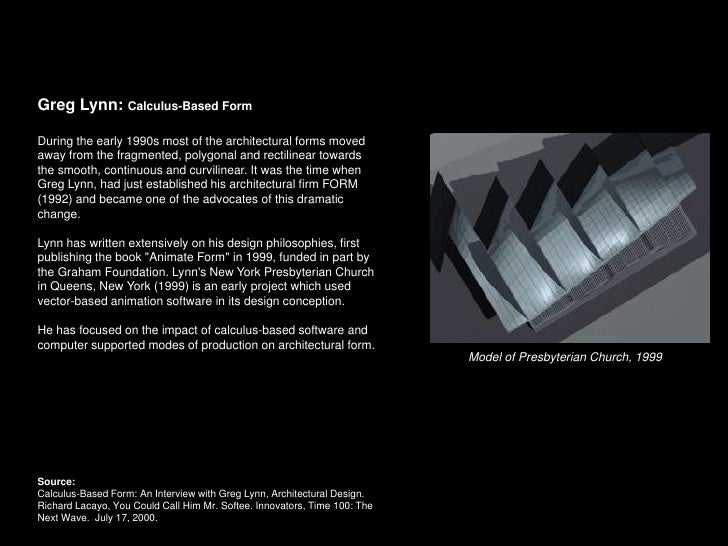Greg Lynn Folding In Architecture Pdf Portfolio

Greg lynn folding in architecture pdf Greg lynn folding in architecture pdf Greg lynn folding in architecture pdf DOWNLOAD! DIRECT DOWNLOAD! Greg lynn folding in. Alternate models within contemporary landscape architecture show the potential of the. Lynn Greg, ed. Folding in Architecture. Full Text (PDF.

This seminal book from Architectural Design was originally published in 1993, at a time of crucial change and on the eve of the digital revolution. It brought together a series of essays that many believe created the favourable environment in which computer--based design could thrive. Considered one of the most influential architecture publications of the 1990s, this book ranks as a classic and in itself is a crucial chapter of history, though one that has been out of print since 1999.
Autodesk Inventor 2008 Download Cracked. This faithful reprinting includes a substantial new introductory essay by Mario Carpo, Head of the Study Centre at the Canadian Centre for Architecture, which examines the impact of the original texts and their ongoing significance. Thereafter, the book is true to its original content showcasing projects by ground--breaking architects such as Greg Lynn, Jeffrey Kipnis, Bahram Shirdel, Frank Gehry and Philip Johnson. Greg Lynn is an architect with practices in Los Angeles (FORM) and New York (United Architects).
He is also a Professor at the Universitat fur angewandte Kunst Wien, Davenport Visiting Professor at Yale University (2004) and Studio Professor at UCLA. Mario Carpo is Head of the Study Centre at the Canadian Centre for Architecture, Montreal; Robert Sterling Clark Visiting Professor of Art History at Williams College (2004); and Associate Professor of Architectural History at the School of Architecture of Saint--Etienne, France (on leave). The Nineties started angular and ended curvilinear. In architecture, they started deconstructivist and ended topological. Castle Miner Z Usb Mods Gta. Seldom has a new trend in architecture encountered such a meteoric rise and fall: it is now generally surmised that the new, smooth and curving forms that characterized the end of the millennium were driven by new computer technologies, and the appeal of digital architecture has already declined alongside the declining fortunes of what was once called the IT revolution. 'Folding in Architecture,' edited by Greg Lynn and first published as an issue of Architectural Design in 1993, is already a classic. A catalyst for the wave of change that was already in the air at the beginning of the decade, it anticipated and ushered in many distinctive features of architecture in the first digital age.
This is a facsimile of that seminal issue, reprinted identically and unabridged, with the addition of new introductory essays by Mario Carpo, Head of the Study Centre at the Canadian Centre for Architecture in Montreal and Greg Lynn. Situated in what can now be aptly defined as its historical context, this reprint offers to contemporary readers a privileged insight into the early steps of a revolution in the making. It will also help to reconstruct the cultural environment that preceded and prompted the mass diffusion of digital technologies in architectural design, and the ambitions and ferments that eventually shaped and inspired the rise of computer-based design and manufacturing. Preface (Helen Castle). Introduction (Greg Lynn). Ten Years of Folding (Mario Carpo).
Unfolding Folding (Kenneth Powell). Architectural Curvilinearity: The Folded, the Pliant and the Supple (Greg Lynn). The Fold -- Leibniz and the Baroque: The Pleats of the Matter (Gilles Deleuze). Folding in Time: The Singularity of Rebstock (Peter Eisenman). Rebstock Park Masterplan, Frankfurt Germany (Peter Eisenman).
Alteka Office Building, Tokyo Japan (Peter Eisenman). Center for the Arts, Emory University, Atlanta (Peter Eisenman). The Points of Space (Frederik Stjernfelt). The Anhalter Folding (Carsten Juel--Christiansen). Towards a New Architecture (Jeffrey Kipnis). Nara Convention Hall (Bahram Shirdel). Scottish National Heritage: A Living Museum (Bahram Shirdel).
Unfolding Architecture (Chuck Hoberman). Out of the Fold (John Rajchman). The Material Fold: Towards a Variable Narrative of Anomalous Topologies (Claire Robinson). Bentwood Furniture (Frank Gehry). Lewis Residence, Cleveland, Ohio (Frank Gehry and Philip Johnson). IN VER(reaeo) T.GO (Thomas Leeser). Prefectura Gymnasium (Shoei Yoh).
Stranded Sears Tower (Greg Lynn). Croton Aqueduct (RAA Um). Computer Imaging: Morphing and Architectural Representation (Stephen Perrella). Interview with Mark Dippe: Terminator 2 (Stephen Perrella). First Interstate Bank Tower: A Note on the Architectonics of Folding (Henry Cobb).